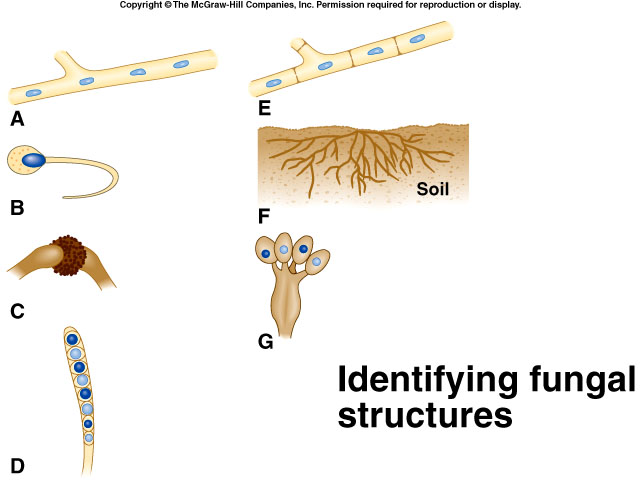1. Identify each structure drawn below from this list:
a. myceliumb. ascusc. zoospored. nonseptate hyphae. basidium with basidiosporesf. septate hyphag. zygospore <a onClick="window.open('/olcweb/cgi/pluginpop.cgi?it=jpg:: ::/sites/dl/free/0072919183/27397/ch23ta.jpg','popWin', 'width=NaN,height=NaN,resizable,scrollbars');" href="#"><img valign="absmiddle" height="16" width="16" border="0" src="/olcweb/styles/shared/linkicons/image.gif"> (50.0K)</a> <a onClick="window.open('/olcweb/cgi/pluginpop.cgi?it=jpg:: ::/sites/dl/free/0072919183/27397/ch23ta.jpg','popWin', 'width=NaN,height=NaN,resizable,scrollbars');" href="#"><img valign="absmiddle" height="16" width="16" border="0" src="/olcweb/styles/shared/linkicons/image.gif"> (50.0K)</a> 2. What characteristics do all types of fungi share? 3. List the characteristics that distinguish the four phyla of fungi. 4. Distinguish between: a. nonseptate and septate hyphaeb. a yeast and a myceliumc. an ascomycete and a basiodiomyceted. ectomycorrhizae and endomycorrhizaee. a saprotroph and a parasitef. a zoospore and a zygosporeg. diploid and dikaryotic5. Give an example of reclassification of a fungus based on molecular evidence. Click Here For The Answers Additional Questions1. To which other kingdoms are the fungi most closely related? 2. Which type of fungus causes: a. Valley feverb. Chestnut blightc. Black wart of potatoesd. Histoplasmosise. Amphibian deathsf. Thrushg. Dutch elm disease3. Name a fungus that has: a. Nonseptate hyphaeb. A flagellumc. Basidiad. Zygosporese. Ascif. Dikaryotic hyphae4. What is yeast? 5. How is the fungal mode of nutrition different from that of plants and animals? Click Here For The Answers | 
